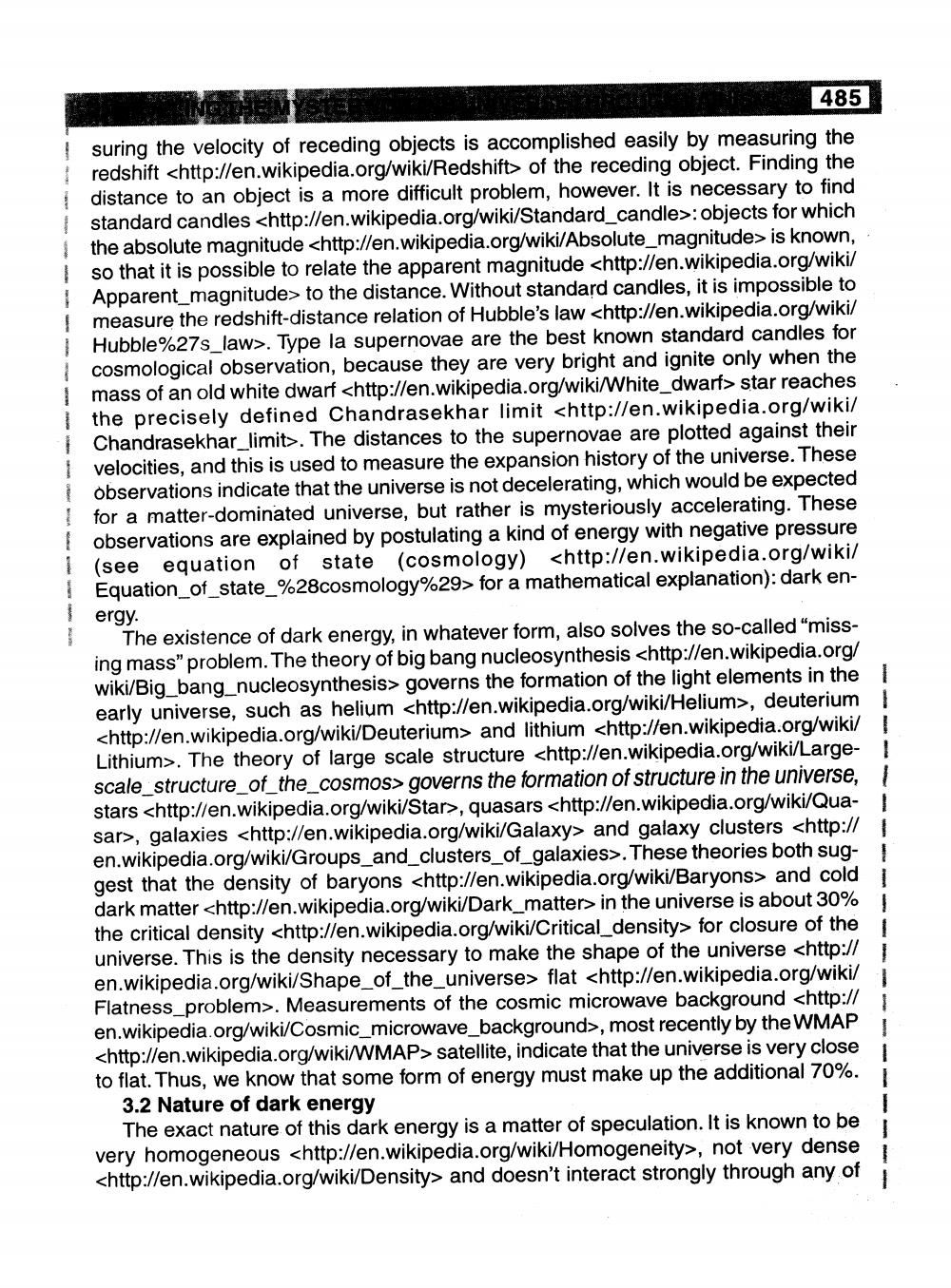________________
485
suring the velocity of receding objects is accomplished easily by measuring the redshift <http://en.wikipedia.org/wiki/Redshift> of the receding object. Finding the distance to an object is a more difficult problem, however. It is necessary to find standard candles <http://en.wikipedia.org/wiki/Standard_candle>: objects for which the absolute magnitude <http://en.wikipedia.org/wiki/Absolute_magnitude> is known, so that it is possible to relate the apparent magnitude <http://en.wikipedia.org/wiki/ Apparent_magnitude> to the distance. Without standard candles, it is impossible to 1 measure the redshift-distance relation of Hubble's law <http://en.wikipedia.org/wiki/ | Hubble%27s_law>. Type la supernovae are the best known standard candles for cosmological observation, because they are very bright and ignite only when the mass of an old white dwarf <http://en.wikipedia.org/wiki/White_dwarf> star reaches the precisely defined Chandrasekhar limit <http://en.wikipedia.org/wiki/ Chandrasekhar_limit>. The distances to the supernovae are plotted against their velocities, and this is used to measure the expansion history of the universe. These observations indicate that the universe is not decelerating, which would be expected for a matter-dominated universe, but rather is mysteriously accelerating. These observations are explained by postulating a kind of energy with negative pressure (see equation of state (cosmology) <http://en.wikipedia.org/wiki/ Equation_of_state_%28cosmology%29> for a mathematical explanation): dark en
ergy.
The existence of dark energy, in whatever form, also solves the so-called "missing mass" problem. The theory of big bang nucleosynthesis <http://en.wikipedia.org/ wiki/Big_bang_nucleosynthesis> governs the formation of the light elements in the early universe, such as helium <http://en.wikipedia.org/wiki/Helium>, deuterium | <http://en.wikipedia.org/wiki/Deuterium> and lithium <http://en.wikipedia.org/wiki/ | Lithium>. The theory of large scale structure <http://en.wikipedia.org/wiki/Large- ! scale_structure_of_the_cosmos> governs the formation of structure in the universe, stars <http://en.wikipedia.org/wiki/Star>, quasars <http://en.wikipedia.org/wiki/Qua- | sar>, galaxies <http://en.wikipedia.org/wiki/Galaxy> and galaxy clusters <http:// en.wikipedia.org/wiki/Groups_and_clusters_of_galaxies>. These theories both suggest that the density of baryons <http://en.wikipedia.org/wiki/Baryons> and cold dark matter <http://en.wikipedia.org/wiki/Dark_matter> in the universe is about 30% the critical density <http://en.wikipedia.org/wiki/Critical_density> for closure of the universe. This is the density necessary to make the shape of the universe <http:// en.wikipedia.org/wiki/Shape_of_the_universe> flat <http://en.wikipedia.org/wiki/ Flatness_problem>. Measurements of the cosmic microwave background <http:// en.wikipedia.org/wiki/Cosmic_microwave_background>, most recently by the WMAP <http://en.wikipedia.org/wiki/WMAP> satellite, indicate that the universe is very close to flat. Thus, we know that some form of energy must make up the additional 70%. 3.2 Nature of dark energy
1
The exact nature of this dark energy is a matter of speculation. It is known to be very homogeneous <http://en.wikipedia.org/wiki/Homogeneity>, not very dense <http://en.wikipedia.org/wiki/Density> and doesn't interact strongly through any of




